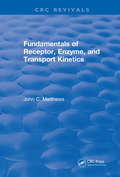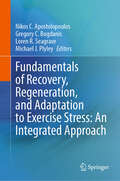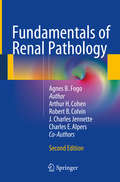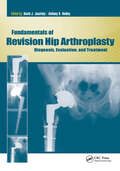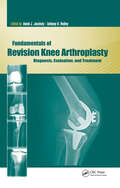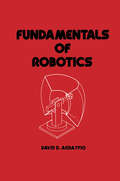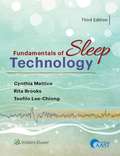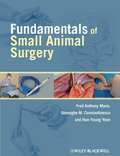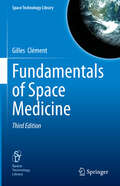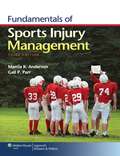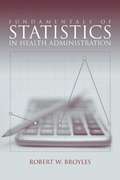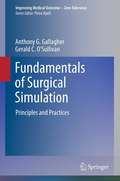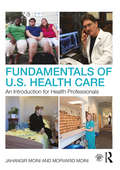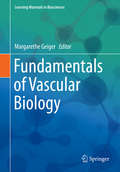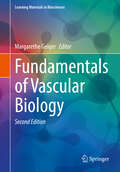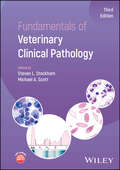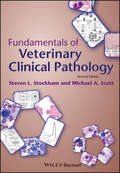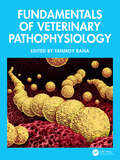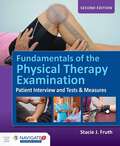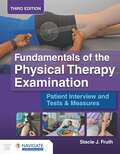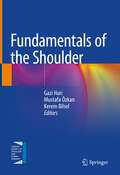- Table View
- List View
Fundamentals of Receptor, Enzyme, and Transport Kinetics (CRC Press Revivals)
by John C. MatthewsFundamentals of Receptor, Enzyme, and Transport Kinetics is the first book to pull together the most important topics in receptor, enzyme, and transport kinetics into a concise, easy-to-use format. Numerous equations are included, and key equations are graphed. For each graphed equation, important features are carefully explained. The book is organized so that simple material is presented first, providing a firm foundation on which to cover the advanced topics which appear later. Terminology used throughout the book is consistent with that used in scientific literature, and concepts are explained using analogies from daily life. The book also features two important appendices that will be particularly useful learning tools. The first appendix outlines all of the key equations from the text and indicates their use. The second appendix is a set of sample calculation problems and their solutions. Fundamentals of Receptor, Enzyme, and Transport Kinetics is an excellent text/reference for pharmacologists, biological chemists, experimental biologists, neurochemists, neurotoxicologists, physiologists, and toxicologists. It is also suitable as a graduate-level text in pharmacology and medical pharmacology.
Fundamentals of Recovery, Regeneration, and Adaptation to Exercise Stress: An Integrated Approach
by Nikos C. Apostolopoulos Gregory C. Bogdanis Loren R. Seagrave Michael J. PlyleyThis volume explores adaptation, recovery, and regeneration, including training foundations, and the issue of tissue damage during physical activity – from basic and applied science perspective, and clinical/practitioner viewpoint. The chapters examine our current understanding of the etiology of tissue damage, and explore current therapy techniques to remediate tissue damage post-injury, as well as strategies to minimize the occurrence of injury through proper preparation. The book employs a multidisciplinary approach to study how to best translate, utilize, and communicate the knowledge developed from current research into actual practice. In addition, the book presents a crucial perspective on how current practice should voice issues and questions to fuel further research in the field. This material will be useful for upper undergraduate degree programs, as well as post graduate programs in kinesiology, physical therapy, occupational therapy, bio-engineering and other health sciences. It is also a good reference for practitioners and researchers in fields involving musculoskeletal heath and sports medicine, and who are interested in the area of tissue adaptation, recovery, and regeneration.
Fundamentals of Renal Pathology
by Agnes B. Fogo Arthur H. Cohen Robert B. Colvin J. Charles Jennette Charles E. AlpersFundamentals of Renal Pathology is a compact and up-to-date resource on the basics of renal pathology that will be of particular value for residents and fellows in training in renal pathology, general pathology, and nephrology, but will also serve as a handy reference for the more experienced. This second, revised and updated edition of the book offers an integrated approach based on contributions from established experts in the field. Key diseases are discussed within the context of clinical presentations, with the emphasis on clinicopathological correlation and differential diagnosis. Topics discussed include glomerular diseases with nephrotic or nephritic syndrome presentations; systemic and vascular diseases affecting the kidney, including diseases affecting the renal transplant; tubulointerstitial diseases; and plasma cell dyscrasias and associated diseases. Well-chosen color illustrations and electron micrographs enhance and complement the text.
Fundamentals of Revision Hip Arthroplasty: Diagnosis, Evaluation, and Treatment
by David Jacofsky Anthony HedleyFundamentals of Revision Hip Arthroplasty: Diagnosis, Evaluation, and Treatment is a unique and very timely book designed for surgeons who are beginning to more commonly encounter hip revisions in their practice. Unlike many traditional books on revision, Fundamentals of Revision Hip Arthroplasty does not focus on the most difficult and challenging of cases. Rather, Fundamentals of Revision Hip Arthroplasty is intended to guide the surgeon in the evaluation of the failed or painful total joint replacement, review basic tenants and surgical principles of revision arthroplasty, and guide the surgeon in determining whether a given case is one that should be managed or is best referred to a tertiary orthopedic center.Along with their 32 contributors, Dr. David J. Jacofsky and Dr. Anthony K. Hedley provide detailed information inside Fundamentals of Revision Hip Arthroplasty, including appropriate preoperative evaluation, equipment requirements, surgical planning, need for augments and allograft, and surgical techniques.Surgeons will be tackling hip revision surgery more frequently as the number of these cases is exponentially increasing. Fundamentals of Revision Hip Arthroplasty provides a “go-to” resource to turn to for guidance by community arthroplasty surgeons, arthroplasty fellows, and residents.
Fundamentals of Revision Knee Arthroplasty: Diagnosis, Evaluation, and Treatment
by David Jacofsky Anthony HedleyFundamentals of Revision Knee Arthroplasty: Diagnosis, Evaluation, and Treatment is a unique and very timely book designed for surgeons who are beginning to more commonly encounter knee revisions in their practice. Unlike many traditional books on revision, Fundamentals of Revision Knee Arthroplasty does not focus on the most difficult and challenging of cases. Rather, Fundamentals of Revision Knee Arthroplasty is intended to guide the surgeon in the evaluation of the failed or painful total joint replacement, review basic tenants and surgical principles of revision arthroplasty, and guide the surgeon in determining whether a given case is one that should be managed or is best referred to a tertiary orthopedic center.Along with their 32 contributors, Dr. David J. Jacofsky and Dr. Anthony K. Hedley provide detailed information inside Fundamentals of Revision Knee Arthroplasty, including appropriate preoperative evaluation, equipment requirements, surgical planning, need for augments and allograft, and surgical techniques.Surgeons will be tackling knee revision surgery more frequently as the number of these cases is exponentially increasing. Fundamentals of Revision Knee Arthroplasty provides a “go-to” resource to turn to for guidance by community arthroplasty surgeons, arthroplasty fellows, and residents.
Fundamentals of Robotics
by David ArdayfioFundamentals of Robotics presents the basic concepts of robots to engineering and technology students and to practicing engineers who want to grasp the fundamentals in the growing field of robotics.
Fundamentals of Sleep Technology
by Teofilo L. Lee-Chiong Cynthia Mattice Rita BrooksEndorsed by the American Association of Sleep Technologists (AAST) and widely used as the go-to text in the field , Fundamentals of Sleep Technology, 3rd Edition, provides comprehensive, up-to-date coverage of polysomnography and other technologies in the evaluation and management of sleep disorders in adults and children. This edition has been extensively updated and expanded to reflect current practice, the latest technology, and the broader roles and responsibilities of the sleep technologist. Content is enhanced with new illustrations, tables, and treatment algorithms. This textbook, written by and for sleep technologists, is the ideal resource for those practicing in the field of sleep medicine or preparing for licensing exams in sleep technology.
Fundamentals of Small Animal Surgery (National Veterinary Medical Ser.)
by Fred Anthony Mann Gheorghe M. Constantinescu Hun-Young YoonFundamentals of Small Animal Surgery offers a thorough introduction to the surgical principles essential to good veterinary practice. With many high-quality pencil drawings and clinical photographs to complement the detailed descriptions, the book is a useful resource for building basic surgery skills. Fundamentals of Small Animal Surgery is designed to provide a grounding in the foundations of veterinary surgical practice and an understanding of the practical application of surgical techniques. Covering topics ranging from assessment and surgical pack preparation to aseptic technique and postoperative pain management, the book is a valuable reference for surgical procedure training in veterinary or veterinary technician schools, and serves as a refresher for veterinarians and technicians in practice.
Fundamentals of Space Medicine
by Gilles ClémentInvestigations in space have led to fundamental discoveries of the human body to the space environment. Gilles Clément has conducted extensive research in this field. This readable text presents the findings from the life science experiments conducted during and after space missions. About 1200 human space flights have been completed to date, including more than 500 astronauts from various countries, for a combined total presence in space of about 90 years. The first edition of this title was published in 2005 (written in 2003 - 2004), and new data is now available from crewmembers participating in long-duration flights on board the International Space Station (ISS). The number of astronauts who have spent six months in orbit has doubled since 2004. On board the ISS, the astronauts use newly developed pharmaceutical countermeasure for bone loss (such as biophosphonates) and state-of-the-art exercise resistive devices against muscle atrophy and cardiovascular deterioration. The ISS life support systems now use advanced closed-loop systems for meeting the needs of a 6-person crew, including recycling urine to water. Some of these new technologies have potential spin-offs for medical (i.e., sedentary life style, obesity) and environmental issues here on Earth. And finally, there are new space research opportunities with the Orion space vehicle that will soon replace the Space Shuttle, the Moon, and Mars space exploration program that is slowly but surely taking shape, and the space tourism sector that has become a reality. The focus on this edition is the ISS, Orion and planetary exploration, and space tourism. This edition also includes more than 20% new material, along with photographs, data, and video clips for Springer Extras!
Fundamentals of Space Medicine (Space Technology Library #47)
by Gilles ClémentThis fundamental 3rd Edition offers a comprehensive overview of performance declines observed in astronauts and cosmonauts throughout various space missions, spanning from Gagarin's flight to the Apollo lunar surface activities, as well as Space Shuttle landings and long-duration stays on board the International Space Station. This evidence forms the basis for identifying risks to crew health and performance during extended space missions, as well as for developing countermeasures to mitigate these risks. In this edition, you'll read how space agencies are currently gearing up for human missions beyond low-Earth orbit, which necessitates addressing numerous physiological, psychological, operational, and scientific challenges prior to establishing bases on the surface of Moon and Mars. The emerging commercial sub-orbital and orbital flight capabilities have captivated both the public and the scientific community. This book also identifies the anticipated hurdles, or "showstoppers," for these space missions and what must be understood to grasp fully the implications and risks for space explorers. Over 650 astronauts from various nations have collectively spent over 184 years in space. Currently, the 72nd expedition crew resides on the International Space Station, maintaining a continuous human presence since 2000. Investigations during this time have explored issues like bone and muscle health, space motion sickness, immune function changes, crew dynamics, and medical challenges such as visual impairment and radiation effects. These studies, including those led by Gilles Clément, have provided valuable insights into human adaptation to space.
Fundamentals of Sports Injury Management (3rd edition)
by Marcia K. Anderson Gail P. ParrThe book focuses on establishing a comprehensive content, 'user-friendly' format for a target audience that includes individuals asked to provide immediate first aid care for physically active individuals across the lifespan in the absence of a certified athletic trainer. These individuals may include coaches, exercise science/health fitness professionals, physical education instructors, supervisors in recreational sports programs and directors in YMCA or other community sports-related programs.
Fundamentals of Statistics in Health Administration
by Robert W. BroylesFundamentals of Statistics in Health Administration fills the needs of both students and practicing health care managers who must apply statistical concepts and methods to real world health care management problems and issues. It covers the fundamentals of statistics in a user-friendly way, with a strong emphasis on practical application in health administration. The text is highly structured with step-by-step instructions throughout. There is an emphasis on Excel and other commonly used programs, although manual calculations are given careful attention as well.
Fundamentals of Surgical Practice
by Andrew N. Kingsnorth Douglas M. BowleyThis extensively revised and updated edition of Fundamentals of Surgical Practice is a key surgical textbook for the intercollegiate MRCS examination. Mirroring the entire new syllabus, it offers trainees a clear understanding of the core knowledge required for examination success and incorporates new material reflecting recent developments and the new examination. Designed to achieve maximum efficiency in learning, the content provides ample detail with key points and suggestions for further reading. In addition to a detailed index, each chapter has its own table of contents to enhance ease of use. The contributors are acknowledged experts, many of whom are recognised in their fields as innovators, practical clinicians, and Royal College examiners. This text is indispensable for the new trainee and provides established surgeons and other healthcare professionals working in the surgical environment with a modern, authoritative overview of the key areas of surgical practice.
Fundamentals of Surgical Simulation
by Anthony G. Gallagher Gerald C. O'SullivanFundamentals of Surgical Simulation explains in detail, from a behavioural science/human factors perspective, why modern image guided medicine such as surgery, interventional cardiology and interventional radiology are difficult to learn and practice. Medicine is currently at a tipping point in terms of how physicians in procedural based medicine are trained. Fundamentals of Surgical Simulation helps drive this change and is a valuable resource for medical trainers and trainees alike. For trainers, this book gives explicit theoretical and applied information on how this new training paradigm works thus allowing them to tailor the application of simulation training to their program, no matter where in the world they work. For the trainee, it allows them to see and understand the rules of this new training paradigm thus allowing them to optimize their approach to training and reaching proficiency in as efficient a manner as possible. For the simulation researcher, engineer and medical profession Fundamentals of Surgical Simulation poses some difficult questions that require urgent unambiguous and agreed answers.
Fundamentals of U.S. Health Care: An Introduction for Health Professionals (100 Cases)
by Jahangir Moini Morvarid MoiniAll health care students must be familiar with the basic concepts of health care in the United States. This introductory textbook presents vital information on health care careers and legal, ethical, financial, and policy issues that will help their future practice. It includes chapters on: careers in the health care profession; the complexity of health care; the Patient Protection and Affordable Care Act; professionalism in health; health care for special populations; the Occupational Safety and Health Administration (OSHA) standards; research and advancements in health care; the future of health care. Fundamentals of U.S. Health Care is unique in the way it highlights the important elements of each health career, including job requirements, length of study, and salaries. With the student in mind, this book is accompanied by a website that features detailed PowerPoints and test banks with more than 1,000 review questions. Well-organized and easily understood, this overview provides a reliable, relevant resource and up-to-date reference. It is essential reading for all allied health students, including nurses, surgical technicians, dental hygienists, radiology technicians, medical assistants, pharmacy technicians, physician assistants, and more.
Fundamentals of Ultrasonic Nondestructive Evaluation
by Lester W. SchmerrThis extensively revised and updated second edition of a widely read classic presents the use of ultrasound in nondestructive evaluation (NDE) inspections. Retaining the first edition's use of wave propagation /scattering theory and linear system theory, this volume also adds significant new material including: the introduction of MATLAB® functions and scripts that evaluate key results involving beam propagation and scattering, flaw sizing, and the modeling of ultrasonic systems. elements of Gaussian beam theory and a multi-Gaussian ultrasonic beam model for bulk wave transducers. a new chapter on the connection between ultrasonic modeling and probability of detection (POD) and reliability models. new and improved derivations of ultrasonic measurement models. updated coverage of ultrasonic simulators that have been developed around the world. Students, engineers, and researchers working in the ultrasonic NDE field will find a wealth of information on the modeling of ultrasonic inspections and the fundamental ultrasonic experiments that support those models in this new edition.
Fundamentals of Vascular Biology (Learning Materials in Biosciences)
by Margarethe GeigerThis well-structured textbook offers essential knowledge on the vascular system. The reader will learn the properties, basic cellular mechanisms and development of the different parts of the vascular system (including the heart), gain knowledge on vascular and related diseases, and will be made familiar with common and most current methods and techniques applied to analyze the vascular system in patients, in animal models, and ex vivo. This book is based on a PhD Course for students from various bioscientific backgrounds given at the Medical University of Vienna, and it will be a valuable resource for Master´s Students in vascular biology and biomedicine in general and a helpful tool for young researchers world-wide wishing to gain or refresh their knowledge in this field.
Fundamentals of Vascular Biology (Learning Materials in Biosciences)
by Margarethe GeigerThis is a fully revised Second Edition of a well-structured textbook that offers essential knowledge on the vascular system. The reader will learn the properties, basic cellular mechanisms, and development of the different parts of the vascular system (including the heart and lung), gain knowledge on vascular and related diseases, and will be made familiar with common and most current methods and techniques applied to analyze the vascular system in patients, animal models, and ex vivo. This book is based on a Ph.D. Course for students from various scientific backgrounds given at the Medical University of Vienna, and it will be a valuable resource for Master´s Students in vascular biology and biomedicine in general and a helpful tool for young researchers worldwide wishing to gain or refresh their knowledge in this field.
Fundamentals of Veterinary Clinical Pathology
by Steven L. Stockham Michael A. ScottProvides the information needed to interpret clinical laboratory assays of domestic mammals Fundamentals of Veterinary Clinical Pathology, Third Edition presents thoroughly updated and detailed information to promote appropriate clinical laboratory testing and interpretation of test results for common domestic mammals. Presented in an easy-to-use outline format complemented by many relevant tables and illustrations, the book is now in full color. This evidence-based guide synthesizes the laboratory principles, physiology, assays, analytical concepts, pathophysiologic states, and pathophysiologic processes relevant to detecting, evaluating, and understanding disorders in dogs, cats, horses, cattle, and camelids. Content additions include two entirely new chapters on synovial and cerebrospinal fluid analysis, as well as expanded sections on blood typing and crossmatching, viscoelastic testing, protein electrophoresis, positive acute-phase proteins, mixed acid-base disorders, vitamin D analysis, analytical and biological variation, blood smear evaluation, and more. New clinical tests and methods, useful data patterns, and additional disorders and pathologic processes are integrated throughout. Providing a conceptual understanding applicable to many species and serving as a valuable clinical reference, Fundamentals of Veterinary Clinical Pathology: Uses consistent terminology and chapter organization featuring separate sections for physiologic concepts, analytical methods, and interpretation of resultsProvides pathophysiologic explanations of laboratory abnormalitiesAllows easy access to information on disorders and conditions, grouping them by common mechanisms or processes and ordering them in parallel across interpretive tables and textFeatures a wealth of high-quality illustrations and photomicrographs throughout the text Includes extensive referencing on the companion website to support statements and provide direction for further reading Fundamentals of Veterinary Clinical Pathology, Third Edition is an excellent textbook for veterinary students taking clinical pathology courses, as well as a valuable resource for clinical and anatomic pathology residents, medicine and surgery residents, and practicing veterinarians.
Fundamentals of Veterinary Clinical Pathology (Second Edition)
by Steven L. Stockham Michael A. ScottThis book provides in-depth information about common clinical laboratory assays that are used to evaluate domestic mammals, including what assays measure, sample or assay conditions that affect results, and what results indicate about the physiologic or pathologic state of a patient. Whenever possible, diseases and conditions are grouped by common mechanisms or processes to promote a conceptual understanding of laboratory data that can be generally applied across many species. New to the second edition are additional disorders, diagnostic tests, illustrations, images, references, and pathophysiologic explanations. This text has proven valuable to students and veterinarians wanting a fundamental understanding of veterinary clinical pathology.
Fundamentals of Veterinary Microbiology
by Andrew N. RycroftA compact and accessible guidebook exploring current understanding of common bacterial and fungal pathogens of animals. Fundamentals of Veterinary Microbiology brings together knowledge and understanding of the bacterial pathogens of animals from disease signs and diagnostic methods to the molecular basis of the host pathogen interaction. A small but focused book, it enables the reader to access important information during diagnosis and treatment in a clinically relevant way. Suitable as a companion for study on the subject and for professional use, the author focuses on the more clinically common diseases at the general and first-referral level. Divided into three sections, the first covers the basics of bacterial microbiology such as structure, growth and genetics. The second examines the commonly encountered bacterial pathogens, with emphasis on current understanding of the cellular and molecular basis of infection and immunity. The third section explores the current state of knowledge of those fungi involved in infection of animals. Specific topics covered in Fundamentals of Veterinary Microbiology include: Nutrition, sterilization, and disinfection of bacteria, bacterial genes and gene transfer, pathogenicity and host response, and vaccination Antimicrobials (action, dynamics, and resistance), typing and identification of pathogens, fungi as agents of disease, Salmonella and E. coli in animal disease and public health. Pathogens transmitted by vectors such as Borrelia, those of endogenous origin such as Clostridium and Pasteurella and those able to spread widely such as Leptospira, Mycobacterium and Chlamydia. Fungal pathogens causing superficial, subcutaneous and systemic mycoses. Fundamentals of Veterinary Microbiology is an essential resource for veterinary students, veterinary nurses, and veterinary practitioners worldwide, allowing them to quickly establish a foundation of knowledge of bacterial pathogens based on clear understanding gained from studies over recent decades.
Fundamentals of Veterinary Pathophysiology
by Tanmoy RanaThis textbook for advanced graduate and postgraduate veterinary students provides a comprehensive overview of clinical physiology with a focus on its application in diagnosing and managing various disorders in animals. Fundamentals of Veterinary Pathophysiology is divided into two main sections. The first section introduces the general aspects of clinical physiology, covering intricate mechanisms such as temperature regulation, animal nutrition, and biological oxidation. It delves into topics like enzymatic regulation, metabolism, the physiology of membranes, body water, and ionic regulation. The section concludes by providing essential insights into the fundamentals of important physiological disorders and dysfunctions. The second section delves into the clinical physiology of disorders within various body systems. It covers digestive disorders in both monogastric and ruminant animals, cardiovascular and respiratory disorders, hematological disorders, neurological disorders, endocrinal disorders, urinary disorders, and lymphatic disorders. Finally, the book concludes with an in-depth examination of the clinical physiology of eye, ear, skin, male reproductive and female reproductive disorders.Key Features Introduces fundamental concepts of clinical animal physiology for advanced graduate and postgraduate veterinary students Emphasizes the practical application of clinical physiology in the diagnosis and managing of animal disorders Provides understanding of intricate physiological mechanisms including temperature regulation, enzymatic regulation and metabolic processes Addresses specific physiological disorders, offering insights into clinical aspects related to digestive, cardiovascular, respiratory and neurological systems Discusses clinical physiology associated with disorders of the eye, ear, skin and reproductive system
Fundamentals of the Physical Therapy Examination: Patient Interview and Tests & Measures
by Stacie J. FruthFundamentals of the Physical Therapy Examination: Patient Interview and Tests & Measures, Second Edition provides physical therapy students and clinicians with the necessary tools to determine what questions to ask and what tests and measures to perform during a patient exam. This text utilizes a fundamental, step-by-step approach to the subjective and objective portions of the examination process for a broad spectrum of patients. This edition has been updated and revised to reflect the new APTA Guide 3.0, and the Second Edition also includes new and extensive coverage of goniometry and manual muscle testing techniques with more than 300 new photographs.
Fundamentals of the Physical Therapy Examination: Patient Interview and Tests & Measures
by Stacie J. FruthFundamentals of the Physical Therapy Examination: Patient Interview and Tests & Measures, Third Edition provides physical therapy students and clinicians with the fundamental, step-by-step information needed to determine questions to ask and tests and measures to perform during a patient exam.
Fundamentals of the Shoulder
by Gazi Huri Mustafa Özkan Kerem BilselThis book comprehensively covers both basic and clinical aspects of the shoulder, from its anatomy and biomechanics, to the diagnosis and treatment of a broad range of shoulder disorders. Designed as a practical and richly illustrated reference guide, it provides the reader with the essentials needed to evaluate and treat shoulder injuries, including radiologic assessments, rehabilitative techniques and surgical procedures (both open and arthroscopic). It includes extensive coverage of the anatomy and pathology, while clinical topics covered include fractures around the shoulder joint, sport injuries and arthroplasty. Written by an international team of experts, who share tips, pearls and pitfalls, as well as best practices from their own experience, the book will be of interest to orthopedic surgeons, physical therapists, rehabilitation specialists and biomechanists alike.
